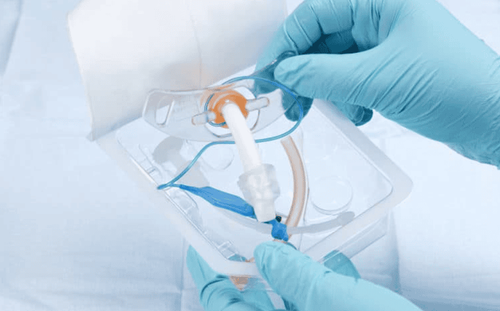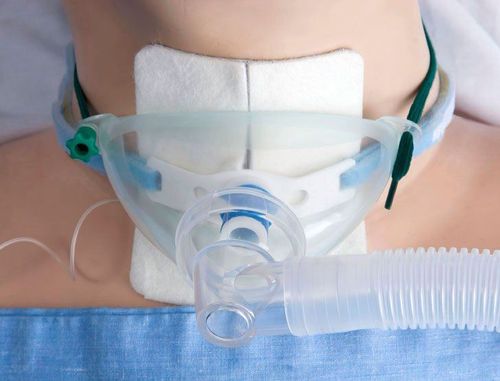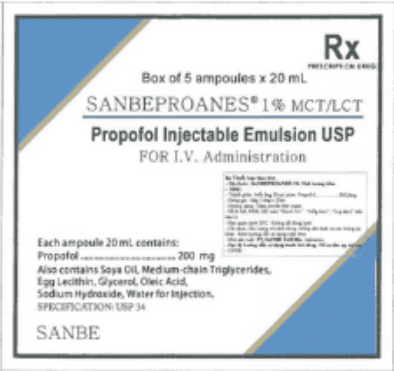This is an automatically translated article.
This article is professionally consulted by Master, Doctor Nguyen Le Duc Hoang - Emergency Medicine Doctor - Emergency Department - Vinmec Danang International Hospital.Caring for the patient's tracheostomy is a daily need to protect the patient's health. Caregiving includes aspiration of sputum, dressing change, tracheostomy lavage, cannula replacement or cleaning, and local anti-infection nebulizer.
1. Outline of tracheostomy procedure
Tracheostomy is the creation of a temporary or permanent airway to bring air directly into the trachea without going through the nasopharynx. This procedure is performed when an upper airway obstruction occurs, helps to remove secretions from the trachea, helps wean off the ventilator, and helps with long-term artificial breathing. The place of tracheostomy is usually in the 2 - 3 - 4 cartilage rings of the trachea.
Indications for tracheostomy:
Cases that obstruct the upper respiratory tract, obstructing ventilation from the nose to the larynx, almost like wounds in the nose and larynx; tumors of the nose, face; laryngeal diphtheria or tracheal foreign bodies; Lesions affecting the respiratory center and the ability to circulate air such as traumatic brain injury, brain contusion, deep coma; complications after surgery brain abscess , posterior fossa tumor , brain tumor ; severe meningitis affecting breathing due to increased secretion of sputum; Thoracic surgeries affecting breathing and alveolar expansion such as lobectomy, pleural dissection and some thoracic and mediastinal surgeries; Acute inflammation in bronchiectasis causes severe asphyxiation in places that are not qualified for intubation; Other cases: Prevention of asphyxiation, preparation for major surgery such as tumors in the lower throat.
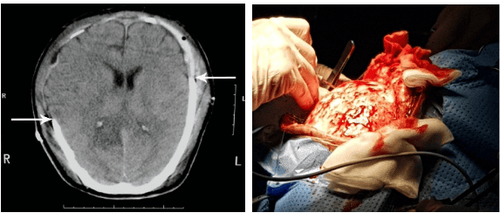
Bệnh nhân chấn thương sọ não cần chỉ định thực hiện mở khí quản
Benefits when performing tracheostomy:
Reducing the dead space of the respiratory apparatus, helping to bring outdoor air into the body easily with breathing movements without exertion; Increase the effectiveness of suctioning phlegm, drool; Helps deliver drugs and oxygen directly to the lower respiratory tract better; There are convenient canuyn for assisted respiration, reduce airway resistance and ensure tidal volume; Reduces stagnation of blood circulation in the venous system. Tracheostomy can cause a number of complications such as sputum congestion, pneumonia, peritubular skin infections, tube collapse, atelectasis, tracheal stenosis, and tracheoesophageal fistula.
2. Details of how to care for a patient with a tracheostomy
2.1 What does the care of the tracheostomy include?
A tracheostomy (also called a stoma) is an airway that directs air into the trachea without going through the nasopharynx. This stoma can be temporary or permanent. In the case of long-term tracheostomy, the patient or loved one must know how to clean and take care to avoid infection.
In the hospital, tracheostomy care includes dressing change, tracheostomy cleaning, cannula replacement or cleaning, and local anti-infective nebulizer. In-home care includes changing the dressing, washing the tracheostomy, changing the cannula (or cleaning the cannula), having an appropriate diet, activity, and exercise, and scheduled follow-up visits.
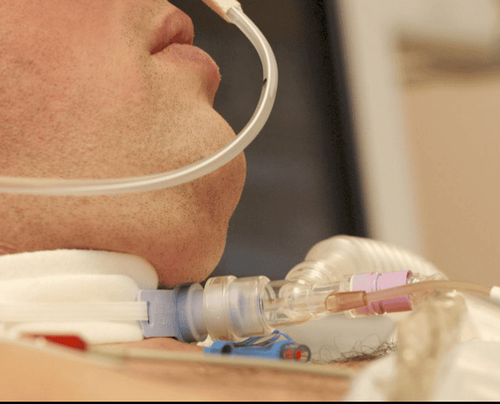
Chăm sóc lỗ mở khí quản tại nhà cần phải thận trọng
2.2 Preparation
Personnel performing: Nursing or technician performing dressing changes, tracheostomy lavage and nebulization; the doctor performs the replacement or cleaning of the canuyn; Means: Dress change kit, sputum suction kit, tracheostomy replacement kit, machine and aerosol mask; Patient: The procedure is explained to cooperate; Medical records: Specify indications and time of procedure.
2.3 Performing the trick
After checking the record and examining the patient, perform tracheostomy care as follows:
Aspiration of sputum, dressing change and wound washing
Sputum suction: Remove sputum before taking care of the tracheostomy; Change the dressing, wash the tracheostomy incision 2-3 times in the first day. Then do it once a day. How to do this: Remove the old bandages and gauze; Disinfect the tracheostomy with alcohol iodine, then disinfect with alcohol 70°; Cleaning secretions, mucus and pus in the tracheostomy opening; Completely disinfected before changing bandages, new gauze; Use fresh gauze to cover the tracheostomy opening; Use gauze to fix the tracheal cannula. Replace canuyn
The doctor performing needs to wash his hands clean; After fixing the outer tube, unlock the inner tube, pull out the inner barrel of the canuyn slightly; Soak the tube barrel in a glass of hydrogen peroxide for a few minutes to dissolve blood and phlegm, then scrub it clean with a small brush. With plastic canuyn, soak in dakin or benzalkonium 1/750 solution for at least 2 hours, then rinse with distilled water. If it is Krishaber silver, it should be steamed, dried or boiled for sterilization; Wipe the canuun again with gauze, reinsert the tube and screw the cannullin in place; Take Y-shaped gauze with a catheter; Use a cotton swab soaked in antiseptic, gently wipe the tracheostomy after 30 seconds, use a cotton swab soaked in physiological saline to wipe the tracheostomy; Cover the catheter with a clean Y-shaped gauze cloth; When the rope is loose or dirty, untie it to fit it or change it to another one.
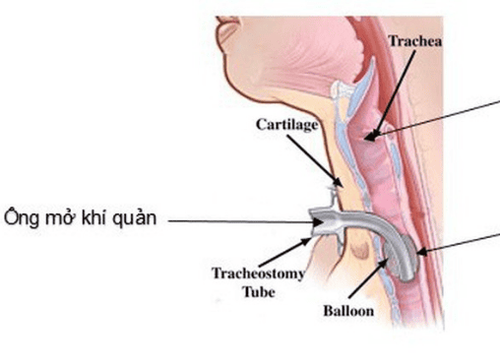
Lỗ mở khí quản cần được thay băng thường xuyên mỗi ngày
2.4 Complications and how to deal with them
Cannus insufficiency: Treat according to the standard treatment regimen; Sputum congestion: Sputum is thick due to dry air, the patient is dehydrated. The treatment is to replenish the patient with enough water, moisten the inhaled air by moistening the gauze covering the cannula, or in the case of mechanically ventilated patients, it is necessary to continuously check the amount of water in the humidifier; Bronchopulmonary infection: Treat by taking bronchial fluid as an antibiotic, then giving the patient broad-spectrum antibiotics and adjusting it after the results of the antibiotic are available.
2.5 Notes for the case of tracheostomy care at home
In case of taking care of patients with tracheostomy at home, the following issues should be noted:
Change the dressing and wash the tracheostomy incision once a day; Observe the skin around the tracheostomy when changing the dressing. If there are signs of skin swelling, redness, bleeding, pus, etc., the patient should be re-examined immediately; Check the position of the tracheostomy tube, check the tracheostomy strap, re-examine immediately if the tracheostomy tube is dropped or falls out; Check the color, nature of sputum and mucus in the tracheostomy tube every time the dressing is changed, re-examine immediately if the sputum increases, there is blood, pus, or the tube is blocked, stuffy; Cover the tracheostomy with a damp gauze to prevent dust and foreign objects from entering the airway; Canuyn replacement or cleaning is performed by doctors at medical facilities with full emergency equipment; About the living regimen for patients with tracheostomy:
Should drink a lot of water, add green vegetables and fruits; Use a steam generator in the room to avoid pneumonia, especially in winter; When sleeping, avoid letting blankets or bed sheets block breathing holes; When bathing, you should cover the breathing hole to avoid water splashing into the airways, causing coughing, choking or suffocation; Practice sports with gentle exercises, suitable for health.
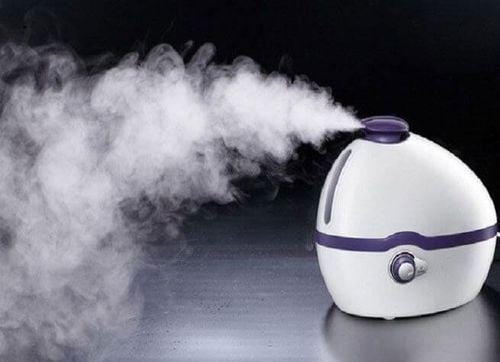
Dùng máy phun sương tạo độ ẩm cho người bệnh để tránh viêm phổi
Patients with tracheostomy should be re-examined immediately if they have 1 of the following symptoms: difficulty breathing, high fever, cough, increased mucus or pus mixed with pus, swelling of the skin around the tracheostomy. , heat, redness, pain, bleeding, pus, retraction or fall of the tracheostomy tube,...
Patients should be examined and treated at reputable hospitals so that possible complications can be well handled. out if the tracheostomy is not cleaned properly. Vinmec International General Hospital is a high-quality medical unit in Vietnam, with a team of well-trained, specialized doctors at home and abroad, with high qualifications and experience.
Modern medical equipment, imported in the US, Japan, the Netherlands... supports the most effective diagnosis and treatment of diseases. Treatment techniques at Vinmec are regularly and continuously updated, keeping up with new trends of world health, providing the most effective treatment regimens.
To register for examination and treatment at Vinmec International General Hospital, you can contact the nationwide Vinmec Health System Hotline, or register online HERE.







